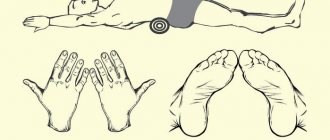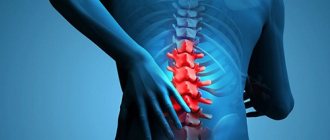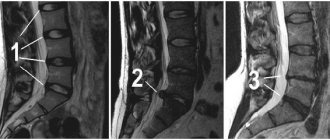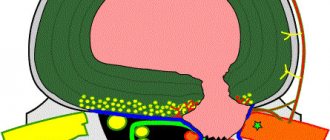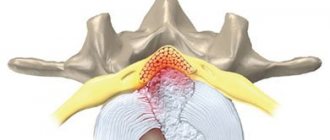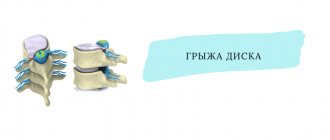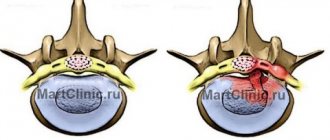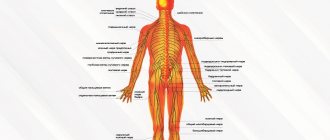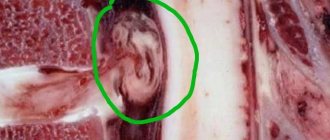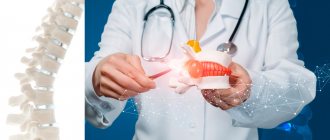Category: »» Articles on neurology
Dubovskaya Nadezhda Alexandrovna
Chief physician of the Clinic, neurologist
Author of the article
Most often, intervertebral hernia appears in the lumbar and cervical spine. This is a rather painful and dangerous disease. Since intervertebral discs serve as shock absorbers to balance the load on the spine, damage to them can have consequences for the entire body and cause a number of unpleasant symptoms. A herniated disc is a rupture of an intervertebral disc. This happens due to a sudden unnatural load on the cervical vertebrae (for example, due to injuries). The consequence is disc deformation and rupture. Further along the chain: the pulpous substance is squeezed into the spinal canal (most often), the nerves are pinched - pain and other ailments occur.
What are the signs of a cervical hernia? Symptoms of a cervical hernia:
As a rule, all patients with cervical intervertebral hernia experience the same, fairly typical symptoms, from which the doctor can easily determine the diagnosis.
First of all:
- severe pain in the neck and when turning the head, shoulder, or arm;
- numbness of the hands or fingers;
- a feeling of “goosebumps” crawling throughout the body;
- weakness in the muscles of the neck and shoulders;
- loss of mobility of the cervical spine due to pain;
There are also less typical symptoms, but still recognizable to a good neurologist:
- frequent dizziness, ringing or noise in the ears and head;
- darkening of the eyes (for example, when tilting the head forward or leaning back);
- decreased vision or hearing;
- the appearance of anxiety, the development of phobias, obsessive states;
- changes in character, obsession, irritability.
However, the nature of the pain, its intensity and specific localization depend on exactly where in the cervical spine the hernia occurred:
- hernia C4-C5 (the 5th intervertebral nerve root is pinched). There is pain and weakness in the forearm and deltoid muscles, especially if you try to raise your arm above shoulder level.
- hernia C5-C6 (the 6th intervertebral nerve root is pinched). The outer part of the elbow hurts, there is pain in the biceps area. A characteristic symptom may also be a feeling of tingling or numbness in the thumb.
- hernia C6-C7 (the 7th intervertebral nerve root is pinched). There are a number of characteristic symptoms here: weakness and pain in the triceps area, numbness in the thumb and middle fingers, and the outer part of the elbow. There may be a feeling of “cottoniness” or “goosebumps” in the hand.
- hernia C7-T1 (the 8th intervertebral nerve root is compressed). There is pain in the lower arm and little finger. Tingling, numbness, and weakness may also occur.
It should be noted that a cervical hernia can cause other painful conditions. After all, with the appearance of a hernia, the vessels are compressed, and the posterior parts of the brain suffer from insufficient blood supply. Patients may experience weakness, nausea, and dizziness. Increased blood pressure and panic attacks may occur. Also, a hernia of the cervical spine (especially if it is located high) can cause migraines - regular intense attacks of headaches. In especially severe cases, vision, attention, memory are impaired, and insomnia appears.
Disc herniation c5 c6: symptoms of the disease and treatment features
Many people suffer from back pain.
It can have different origins. One of the common causes of this problem is intervertebral hernia. What kind of disease is this? How to detect it? Why does a hernia form? What therapies are used? Is it possible to treat a hernia without surgery?
Intervertebral herniation is a common disease in which the contents of the disc extend beyond its boundaries. Most often, a herniated disc is diagnosed in older people. But it is often found in young people.
Intervertebral hernia - symptoms and treatment
Treatment is prescribed to the patient based on causal and symptomatic therapy. Symptomatic therapy is aimed at easing and relieving pain. For this purpose, means are used whose task is to change the impaired functions of the nerves, and means aimed at eliminating inflammatory foci.[2]
Drug treatment
For severe pain it is prescribed:[9]
- promedol;
- glucocorticoids (diprospan, dexamethasone);
- NSPS (Diclofenac, Voltaren, Xefocam, etc.);
- chondroprotectors (Hyaluronic acid, Chondroitin sulfate, Glucosamine sulfate);
- B vitamins (B1, B6, B12);
- vitamin C;
- vascular drugs (Actovegin, Trental, Lysine aescinate, etc.);
- muscle relaxants (Mydocalm, Sirdalud, Baklosan, etc.);
- antidepressants (Amitriptyline, etc.).
Manual therapy, exercise therapy and massage
Exercise therapy and massage can reduce pain, but do not eliminate the hernia. The effectiveness of manual therapy for the treatment of hernia does not have sufficient evidence. Since 2021 in Russia, the methodology has been removed from the nomenclature of medical and pharmacist specialties; certificates for this type of activity are no longer issued.
Physiotherapy methods:
- UHF;
- electric light baths;
- electrophoresis with novocaine;
- irradiation with ultraviolet rays;
- ultrasound;
- diadynamic currents;
- salt and pine baths;
- radon baths;
- mud therapy.
Spinal traction
In case of damage to the intervertebral discs with compression of the roots, traction is indicated. In modern clinics, traction is performed on special traction tables with a connected electric drive.
In the acute period - rest, the patient is placed on a hard mattress or wooden board.[9] Painkillers are prescribed.
Surgery
Surgery for intervertebral hernias should be performed after conservative treatment has been tried. Indications for surgery include a long course of the disease, frequent relapses, lack of effect from conservative treatment, and the appearance of caudal and spinal symptoms, at least to a mild degree.[2]
Discectomy has been shown to be an effective treatment for acute disc herniation regarding neurological symptoms, but does not eliminate the consequences of altered biomechanical properties of the segment. In this situation, the surgeon is faced with a dilemma about how to perform a major discectomy: if only the extruding material is resected, there is a risk of recurrent disc herniation; however, if all or most of the disc tissue is resected, there is also a significant likelihood that loss of biomechanical function will lead to instability or collapse of the segment. Because of slowly progressive disc degeneration, which is associated with cellular aging, increased catabolic activity, and decreased matrix synthesis, cell therapy is an attractive approach to intervertebral disc regeneration.[10]
Recovery after removal of intervertebral hernia
After surgery, you should not lift heavy objects and the load on the spine should be evenly distributed. Patients are often referred for post-operative rehabilitation, which may include exercise and physical therapy techniques. However, data on its effectiveness are insufficient, and results in the published literature are contradictory [11][12].
Myths and dangerous misconceptions about hernia treatment
The main myth is the benefits of manual therapy, especially trusts and crunches. These methods, as well as home remedies , such as various compresses, are not effective against hernia.
Anatomical features
The spine consists of 24 vertebrae connected by intervertebral discs that perform a shock-absorbing function. The discs are surrounded by a hard shell called the annulus fibrosus. Inside they are filled with gel-like contents - the nucleus pulposus.
Vertebrae consist of bodies and arches. The arches form the spinal canal, a vertical cavity that houses the spinal cord. Spinal nerves depart from it, which transmit impulses to all organs, regulating their activity.
Treatment of herniated cervical spine
Treatment of a neck hernia can be carried out without surgery , only with the participation of an experienced specialist. In addition, it is necessary to take into account the importance of comprehensive diagnostics, which includes radiography, CT and MRI. This will allow the doctor to create the correct treatment plan and get the most effective results.
Remember that for complete restoration of the spine, a set of measures should be used, including not only the use of medications and folk remedies, but also the use of physiotherapeutic methods and physical therapy.
At the present stage of development of society, the method of exposure to shock waves is the most effective. We will talk about its advantages below.
Treatment of cervical disc herniation without surgery: the role of shock wave therapy
It is impossible to overestimate the importance of shock wave therapy in restoring pathological conditions of the spine and musculoskeletal system. The method is based on the use of acoustic waves with a frequency of up to 16 Hz, which are not perceived by human hearing. The effect of such infrasonic vibrations is identical to the effect produced during acupressure, only with a higher frequency.
At the same time, shock waves have the ability to easily overcome muscle tissue and liquid media. In turn, lingering in cartilage and bones, they provide an impulse of energy that quickly crushes pathological formations, for example, osteophytes. This relaxes the muscles and relieves pain.
Most often, in case of hernia and protrusion of the cervical spine and the need for non-invasive treatment of these ailments, a course of 15–20 sessions is prescribed. Depending on the individual situation, a special focusing head is used that can penetrate into the deep layers of the spine (up to 4 cm).
That is, when it comes to intervertebral hernia of the cervical spine, and the most effective methods of treatment, shockwave therapy is the winning option. As mentioned above, this helps restore tone, improves the condition of the vertebrae, normalizes blood flow and eliminates pain. However, to achieve maximum effectiveness, it is advisable to combine this technique with other conservative methods of treating cervical hernia.
These include: manual therapy, the use of a special diet, the use of folk remedies, physical therapy, and other procedures. These are the ones that will be discussed further.
If you are concerned about a cervical hernia, in our clinic you can undergo treatment with shockwave therapy at one of the lowest prices in Moscow.
| Service | price, rub. |
| Shock wave therapy (SWT) treatment consultation | for free |
| Herniated Disc Treatment Procedure Blue Tip/Red Tip | 1200 / 1600 ₽ |
| Discount on the initial visit to the clinic | 20% |
Make an appointment Online booking
- Clinic on Krasnopresnenskaya +7 (499) 252-41-35 Volkov lane, 21
- Clinic on Varshavskaya +7 (499) 610-02-09 Varshavskoe highway, 75, building 1
- Clinic in Annino +7 (495) 388-08-08 Varshavskoe highway, 154, building 1
Drug treatment of cervical disc herniation
Treatment of a herniated cervical spine without surgery involves, first of all, the use of special medications. Their action is aimed at eliminating the main signs of the disease, as well as preventing the dangerous consequences of a hernia.
These funds include:
- Anti-inflammatory agents. These include non-steroidal drugs that can quickly eliminate the inflammatory process, relieve swelling and pain, and also relax muscles;
- Painkillers and antispasmodics. Help eliminate pain in various parts of the spine and other organs to which pain radiates;
- Medicines to relieve muscle tension. To eliminate spasms in muscle tissue, the patient is prescribed muscle relaxants;
- Chondroprotectors. Promotes the restoration of damaged cartilage tissue;
- Vitamin complexes. To speed up the healing process and improve the general condition of the patient.
Features of the use of physiotherapeutic procedures
14-21 days after starting to use medications and eliminating pain, experts advise moving on to physiotherapeutic procedures.
They are prescribed to achieve the following positive effects:
- Restoration of metabolic processes in a specific area;
- Normalization of blood circulation;
- Improving the ability of cells and tissue to regenerate;
- Removal of residual pain. Patients who have undergone treatment for a cervical hernia leave reviews indicating noticeable improvements already after the 3rd procedure;
- Elimination of muscle spasms. This allows you not only to relax your muscles, but also to relieve nervous tension.
The essence of acupuncture
One of the most proven methods, acupuncture, is based on physiotherapeutic effects associated with irritation of skin receptors. This allows you to launch regeneration processes in the skin structures and restore metabolism. In addition, by resorting to this method, you can quickly cope with pain.
The role of neck corsets
If you are interested in treating a cervical disc herniation without surgery, a specialist may recommend using special orthopedic collars. The role of such cervical corsets cannot be overestimated, since they provide reliable fixation of the spine in the cervical region, preventing the development of complications in the future.
Moreover, when a herniation of the cervical spine disc c6 c7 is diagnosed, treatment should be aimed primarily at reducing the load on this area. This is also facilitated by the use of a fixing corset. It eliminates spasms and tension in the muscles, thereby relieving pain. However, it is not recommended to use such a device constantly, since it can cause atrophic processes in muscle tissue.
Make an appointment Online booking
- Clinic on Krasnopresnenskaya +7 (499) 252-41-35 Volkov lane, 21
- Clinic on Varshavskaya +7 (499) 610-02-09 Varshavskoe highway, 75, building 1
- Clinic in Annino +7 (495) 388-08-08 Varshavskoe highway, 154, building 1
Kinesitherapy is one of the types of physical therapy
A set of special physical exercises, called kinesitherapy, is performed immediately after completing medication. This method of treating a herniated cervical spine without surgery is also considered one of the most effective and allows you to restore tissue nutrition, but remember that during physical activity there should not be any pain.
In addition, if there is a hernia in the cervical spine, treatment through gymnastics should be carried out with the participation of an experienced rehabilitation physician.
Use of folk remedies
If you have been diagnosed with a cervical hernia, treatment with folk remedies . But this method should not become an absolute alternative to the use of medications. Moreover, before using it, you must visit a competent specialist who will give detailed answers to all your questions.
The most effective methods include:
- The use of compresses with horse fat;
- Alcohol infusions with the addition of garlic;
- Baths with the addition of sea salt.
Features of using the Glisson method
In order to treat a hernia of the cervical spine without surgery, they also resort to using a special device - a Glisson loop. This device is widely used to prevent and combat ailments that occur in the spinal column in the neck area.
Thanks to the use of a Glisson loop, it is possible to eliminate compression in the vertebral area, ensure normal nutrition of cells and relax nearby muscles. Positive effects are achieved by fixing the device on the head and using special weights.
To prevent dangerous consequences, it is recommended to carry out the above procedure under the supervision of an experienced specialist.
Special diet
If a patient is diagnosed with a C5 C6 disc herniation in the cervical spine, a prerequisite for successful treatment is the use of dietary products. Moreover, the dishes used for food must be enriched with important microelements and vitamins, without containing harmful substances. It is also necessary to exclude spicy, fried and fatty foods from the diet. Quitting alcoholic beverages and tobacco products is also included in the list of prohibited items.
The list of foods containing vitamins important for the spine includes:
- Dairy and fermented milk products;
- Seafood;
- Eggs;
- Beef and chicken liver;
- Various cereals;
- Vegetables: carrots, cabbage, pumpkin, greens, etc.;
- Red berries and citrus fruits.
In addition, it is important to follow the correct cooking technology: to preserve nutrients, they should be baked, boiled or steamed until cooked.
Massages are another effective way to treat illness.
When there is an intervertebral hernia of the cervical spine, massages should be a mandatory stage of treatment. However, their help is resorted to only after pain has been eliminated. The minimum massage course is 10 procedures.
Thanks to this conservative method, it is possible to restore the elasticity of ligaments, relax muscle structures and cope with pinched blood vessels and nerve endings. But to achieve a successful result, such therapy must be carried out with the participation of a qualified and experienced rehabilitation therapist.
Kuznetsov applicator
Often, treatment of a hernia of the cervical spine in Moscow is carried out using another effective device - the Kuznetsov applicator. You can lie on such a roller, or use it to actively influence the affected area by rolling.
Through the use of such a device, it is possible to quickly normalize blood flow in muscle structures and the spine, eliminate tension in them and cope with acute pain in the head area.
Make an appointment Online booking
- Clinic on Krasnopresnenskaya +7 (499) 252-41-35 Volkov lane, 21
- Clinic on Varshavskaya +7 (499) 610-02-09 Varshavskoe highway, 75, building 1
- Clinic in Annino +7 (495) 388-08-08 Varshavskoe highway, 154, building 1
Efficiency of electrophoresis
This physiotherapeutic method is based on the action of a stream of discharged particles emitted by special equipment. Such particles easily penetrate bone structures, soft tissues and skin. In this case, medications necessary to enhance the positive effect are applied to the skin in advance.
This method gives a pronounced antispasmodic, anti-inflammatory and analgesic effect.
Administration of painkillers
In this case, we are talking about a blockade and the introduction of drugs into the affected area to relieve severe pain. For this purpose, novocaine and lidocaine are used simultaneously with antispasmodics.
An important advantage of this method is the prolonged antispasmodic effect.
The importance of physical therapy
To obtain a relaxing and strengthening effect for the muscles, as well as traction of the spine, special training is carried out. However, to achieve maximum positive results, they should be carried out with the assistance of an experienced physiotherapist.
How does a hernia form?
Due to various unfavorable circumstances, the integrity of the fibrous ring is disrupted and the nucleus pulposus begins to fall into the spinal canal, which leads to compression of the nervous structures and the occurrence of unpleasant symptoms.
In some cases, a sequestered hernia develops, in which part of the nucleus falls off and remains in the spinal canal.
The most common hernia is lumbar. A little less often, the pathology affects the cervical spine and only sometimes the thoracic spine. The neck is the most vulnerable place of the spine. In addition, blood vessels pass through it, supplying nutrients and oxygen to the brain, as well as nerves through which information from the brain flows to all organs. Therefore, you should not delay treatment. It is better to consult a doctor if you experience the slightest discomfort in your neck.
In most cases, a C5 C6 intervertebral disc herniation is diagnosed. The letter “C” marks the cervical vertebrae, of which humans have seven. Consequently, the diagnosis of “C5 C6 disc herniation” means that the pathology is localized between the fifth and sixth vertebrae.
Pathological changes are also often observed in the C6 C7 segment, a little less often in C4 C5. The C7 T1 segment, which connects the cervical and thoracic spine, is extremely rarely affected.
Diagnostics
If you experience neck pain radiating to the shoulder girdle, head and arms, you should consult a neurologist or vertebrologist. The doctor will conduct an examination and, if there is a suspicion of a hernia of the neck of the 5th and 6th vertebrae, prescribe instrumental diagnostic methods:
- CT;
- MRI;
- X-ray;
- electromyography.
The most complete information about the condition of the cartilaginous bodies of the spine is provided by MRI. The method allows you to obtain layer-by-layer images of tissue and accurately assess the location of the protrusion and its size.
Symptoms of a herniated disc
Symptoms can vary significantly due to the location of the hernia and its size, as well as the individual characteristics of the patient.
The first sign that indicates a problem in the neck area is pain, which is found not only in the affected area. Quite often the pain radiates to the arm.
Gradually, the disease will begin to progress, resulting in new symptoms.
A C5 C6 disc herniation is usually accompanied by:
- stiffness of the neck and limitation of its mobility;
- numbness and tingling in various parts of the upper limb;
- weakening of the arm muscles (biceps of the front side of the shoulder and triceps of the wrist), making it difficult to perform the necessary manipulations;
- pain and numbness in the shoulder;
- pain in the interscapular area and under the scapula;
- headache (usually starting from the back of the head);
- dizziness;
- high blood pressure or pressure surges.
In very rare cases, when an intervertebral hernia compresses the spinal cord, the following appear:
- severe weakness in the arms, making it difficult to perform small movements (for example, fastening buttons, grasping objects);
- hand tremors;
- difficulties that arise during normal walking, unstable gait;
- inability to control urination or bowel movements.
In these cases, emergency medical attention is required.
Rehabilitation
How the rehabilitation will proceed and what restrictions will be imposed depends on the type of surgery performed. After hydroplasty, the patient can leave the clinic on the same day, completely free of pain and return to their usual lifestyle. Endoscopic removal of a C5–C6 disc herniation involves a hospital stay of several days.
After microdiscectomy, the patient is usually discharged from the hospital on days 5–7, but full recovery requires several months. During this period, patients are prohibited only from serious physical activity; no other restrictions are imposed.
To speed up the recovery process, the following are prescribed:
- drug therapy - analgesics or NSAIDs are usually recommended to eliminate postoperative pain and inflammation;
- physiotherapy – magnetic therapy and electrophoresis procedures accelerate tissue regeneration processes;
- Exercise therapy – special exercises help strengthen muscles and create reliable support for the spine;
- wearing an orthopedic collar helps reduce the load on the cervical spine.
It is gymnastics for a hernia of the cervical spine C5–C6 that helps prevent relapse and avoid the formation of protrusion in another spinal motion segment. And to improve results, patients are recommended to visit the pool regularly.
Thus, the treatment tactics for C5–C6 hernia are well established. But in order for the treatment to be effective and less traumatic, you should contact only vertebrologists who are well versed in the intricacies of diagnosing and treating spinal diseases. It is this specialist who will be able to tell whether surgery is needed in a particular case or not.
Diagnosis of the disease
First, the patient is examined by a neurologist. He studies the medical history, asks about disturbing symptoms, checks reflexes, skin sensitivity, and muscle strength.
To confirm the presence of a hernia, the patient is referred for examinations:
- radiography - it is unable to detect a hernia, but will help identify fractures and displacements of the vertebrae, neoplasms, infections;
- myelography (used in rare cases, since the image quality is low) - this is the name for radiography, during which a contrast agent is injected into the spinal canal;
- electromyography – studies nerve conduction and its strength, making it possible to determine the location of nerve damage;
- computed tomography (due to the low quality of the images, usually used in cases where magnetic resonance imaging is not possible) – provides two-dimensional images of the soft and bone tissue of the spinal column;
- magnetic resonance imaging - provides high-quality three-dimensional images of bones and soft tissues, shows the location and size of the hernia, as well as pinched nerve structures.
To increase diagnostic accuracy, several methods are usually combined.
Treatment of paramedian hernias
The success of conservative treatment of paramedian hernias directly depends on how competent the specialist is and on how responsible the patient is. If he fully complies with all the doctor’s instructions, the success of treatment can be predicted in most cases.
Conservative therapy is used if there are no indications for emergency surgery. It involves taking medications: analgesics, non-steroidal anti-inflammatory drugs, muscle relaxants, corticosteroids, drugs that have a positive effect on tissue nutrition. Injections can be performed directly into the location of the hernia, as well as massages, ultrasound therapy, therapeutic exercises, spinal traction, etc.
Surgical intervention at the CELT clinic is resorted to in the most extreme cases. The operation itself is performed by experienced specialists using modern equipment and drugs to minimize the possibility of complications and blood loss.
Types of foraminal hernia
Foraminal hernias, in turn, are divided into several subtypes, depending on the direction in which they form.
2.1 Median-foraminal hernia
Median-foraminal hernia is diagnosed in cases where bulging of the fibrous ring with prolapse of the sequestrum occurs along the central line of the vertebra in the anterior or posterior direction. Determining the location of such a hernia is quite simple - it coincides with the localization of the patient’s painful sensations. A medial disc herniation is dangerous because it affects and damages the spinal canal that runs along the spinal column. The larger the hernia, the greater the compression, the greater the pain.
2.2 Circular foraminal hernia
The least common type of hernia is circular foraminal. It is characterized by a uniform distribution of elements of the destroyed intervertebral disc in the direction of the intervertebral canal. In the presence of such a hernia, it becomes difficult to make movements, and general mobility is impaired. There is swelling in the area where the hernia is formed, which causes compression of the nerve roots and spinal cord.
2.3 Right-sided and left-sided foraminal hernias
Already from the name of these types of hernias it is clear that they are distinguished by their exact localization - on the left or on the right. The most common hernia occurs on the left side. Such hernias are dangerous because they compress the nerve structures in the spine or affect the state of the nervous system as a whole. Occurring in the cervical region, a left-sided foraminal hernia can cause a sharp headache in the patient and cause hearing or vision impairment.
Treatment of median hernia
Treatment of a median hernia in the CELT clinic is always effective, prompt and successful. The process uses modern equipment and drugs that allow you to achieve the desired results. Surgical intervention is practiced only if there are indications for it or conservative treatment has not brought the desired effect.
This treatment method, epidural blockade, has proven itself well. It allows you to achieve pain relief, which occurs immediately after the procedure, lasts up to six months and has a therapeutic effect. Thanks to this manipulation, you can significantly delay, and often even refuse, the operation.
When prescribing treatment, our specialists are primarily guided by the interests of our patients; treatment is always built on trust and interaction, which also brings excellent results!
Cost of treatment for cervical disc herniation
| Service | price, rub. |
| Shock wave therapy (SWT) treatment consultation | for free |
| Herniated Disc Treatment Procedure Blue Tip/Red Tip | 1200 / 1600 ₽ |
| Discount on the initial visit to the clinic | 20% |
| Primary consultation with a surgeon, consultative and diagnostic | 1500 ₽ |
| Repeated appointment with a surgeon, consultative and diagnostic | 1000 ₽ |
| Surgical hernia removal | 30 000 ₽ |
Paramedian, median and foraminal hernia C6-C7
Median hernia C6-C7 is a protrusion of the nucleus pulposus in the upper or lower projection of the surface of the fibrous ring (they are in contact with either the upper or lower vertebra. This hernia is characterized by severe pain, constant injury occurs due to pressure from the vertebral endplate.
A paramedian hernia of C6-C7 is a protrusion in the lateral projection on the left or right side. Uncomplicated paramedian C6-C7 disc herniation produces clinical symptoms reminiscent of osteochondrosis. This is pain, stiffness of movement, muscle fiber tension.
Foraminal hernia C6-C7 is a type of paramedian hernia. It is located in the area of the foraminal openings in the vertebral bodies. The radicular spinal nerves pass through them. Therefore, immediately after the appearance of a foraminal hernia, a picture of acute radiculitis develops, and after 2–3 days, signs of a lack of innervation appear in certain areas of the body (paralysis, lack of skin sensitivity, etc.).
Diagnosis of circular hernia
In order to prescribe treatment, doctors at the CELT clinic conduct diagnostic studies to accurately determine the location of the hernia, its size and effect on surrounding tissues. Our clinic is equipped with modern:
- magnetic resonance imaging;
- computed tomograph;
- radiographer.
All of them allow us to conduct the necessary research at a high quality level and provide data for making the correct diagnosis.
Why is a C6-C7 cervical hernia dangerous?
The most dangerous localization is a posterior herniation of the C6-C7 disc, which can compress the structures of the spinal cord. In this case, the activity of not only the upper limbs may be disrupted. Impaired function of the cardiovascular and respiratory systems in such situations often leads to death.
External vertebral hernia C6-C7 (directed outward from the spine) is no less dangerous. It can compress the radicular nerves responsible for the innervation of the internal organs of the chest. With a serious disturbance of innervation, thyroid dysfunction, heart rhythm disturbances, and increased blood pressure are observed. Damage to the brachial plexus leads to paresthesia, decreased skin sensitivity and even paralysis of the arm.
The next thing that is dangerous about a hernia of the C6-C7 cervical spine is a violation of cerebral circulation. In the region of the sixth cervical vertebra, the posterior vertebral arteries emerge from the thoracic cavity. They are responsible for the blood supply to the posterior structures of the brain. When compression by a hernial protrusion causes a clinical picture of acute cerebrovascular accident. With chronic partial obstruction of hernias, the patient develops decreased visual and hearing acuity, arterial hypertension, and decreased brain activity. There are constant dizziness, muscle weakness, drowsiness, nausea. At the height of the headache, panic attacks may develop. A person is constantly depressed, depressed.
Treatment
Treatment of foraminal hernia can be of several types.
5.1 Conservative therapy
Conservative therapy consists of selecting the most effective painkillers, prescribing a set of physical therapy and gymnastics exercises, massage, manual therapy, and physiotherapeutic procedures. This treatment is prescribed in cases where the hernia protrusion is small.
5.2 Surgery
If there is a large intervertebral hernia or protrusion, as well as if conservative therapy is ineffective, surgery may be indicated for the patient. Modern medical technologies make it possible to quickly remove hernias without significant incisions and without injuring the spine itself. Such operations are most often performed endoscopically.
Which doctor should I contact?
For the treatment of median-foraminal, circular-foraminal, paramedian, left-sided, right-sided and other types of hernia of the lumbar or cervical spine, you should contact a neurologist
.
Some of the best specialists in this field work at the Energo clinic and will be happy to help you with your problem. If the disease turns out to be serious enough, then neurologists, in the process of diagnosing and prescribing therapy, can work in tandem with massage therapists
, physiotherapists,
massage therapists
and other specialists who have extensive experience in dealing with pain and its causes.
